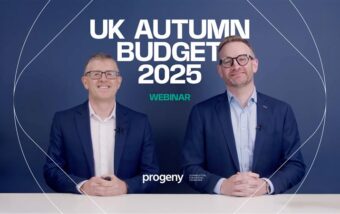It proved to be a positive month for growth assets in May, as trade tensions subsided between the US and the EU.
Ian Hooper, Chief Investment Officer and Sarika Dhanjal, Head of Asset Management discuss the implications from ‘Liberation Day’ and provide an overview on financial markets for investors and developing themes for the coming months.
Transcript
Sarika: Hello and welcome to the latest Market Insight. Today we’ll be looking at what’s been happening over the last month and also what the impact is in the future. Today I’m joined by Ian Hooper who is Progeny’s Chief Investment Officer. So Ian, let’s start with the bigger picture. May seemed to be a positive month for growth assets. What were the key drivers behind that?
Ian: The main driver in May was tariffs. This time it was a risk on month. Risk assets were in play. Equities performed well mainly because there was a pause in the US, EU tariff discussions. The market took that as a read that we might avoid some tough recessionary conditions. So that was the main reason that the growth assets performed well through the month.
Sarika: We’ve looked at the growth asset side. What about defensive assets, what was going on in that space?
Ian: So, with defensive assets, the headline that dominated was the downgrading of US treasuries or the US credit rating. The US held on to one rating of triple A from Moody’s, the other credit agencies, S&P and Fitch downgraded from triple A some time ago. That was removed in May. Now, it’s not a real surprise given the challenges of tariffs and the ballooning budget deficit. That was the reason Moody’s said they would take a notch off the credit rating because numerous administrations have not dealt with this ballooning deficit and these interest payments.
We’ve talked before about the problem that the US has as its debt pile gets bigger, furnishing that debt pile becomes a drag on the economy. That’s ultimately the reason why there was a change to the credit rating. That shook the markets mid-month.
Sarika: So on the back of that news, have we seen the impact of that news fully play out now, or is there going to be more drama behind that?
Ian: I think the markets were sort of expecting it. It did impact in the very short term, treasury yields increased. Investors wanted to be compensated for more risk. There’s more perceived risk in owning US treasuries than before. But things settled down by the end of the month, which tells me that the markets had already started to price in that would happen.
Sarika: So a few months on from Liberation Day, investors are still seeing the impact. What’s your view on how this is going to play out in the future?
Ian: I think there’s a number of trends starting to develop around the impact of Liberation Day that started to embed in May.
I think as investors, we’re going to have to get used to these trends and themes over the coming months, well into the summer. The first trend is the stop-start of global trade. We looked at data from the US. Imports surged into the US into March.
Then we had a big hike in tariffs with China and they collapsed. So, it’s this stop-start seesawing that is inevitably going to happen while we go through the Liberation Day tariff discussion.
The second trend is tariffs themselves. The US tariffs are going to be higher than historical levels. We think they’ll be around 50%. At the end of the Biden administration, they were around 2.5%. Economies are going to feel that headwind.
The third trend is global trade with China. The World Bank has warned that China has around $400 billion worth of manufactured goods that it needs to find new markets for.
So, there are probably more themes and trends we could pick up on, but I think those are the three that investors will be watching closely as we go into the summer.
Sarika: It’s good to understand these trends. But I want more detail on is how these headwinds have affected the US and US shares?
Ian: In May, US equities were the best performing developed markets area, that books the trend we’ve seen from the start of 2025. There’s a real thing to pick up on here: backward-looking data telling a really positive story in terms of results. Then this fragility of forward-looking data. That’s where the Liberation Day themes may start to impact over the coming months. Let’s focus back on May.
Most companies announced results, and on a blended year-on-year growth rate basis, the numbers were up about 12.4%.
The backward-looking Q1 data was strong. That was announced in May, which is why we saw positive US markets. But as investors, we want to understand what’s coming down the track. That’s where it starts to become not as clear.
For example, Q2 expectations are that earnings will drop by around 3% earnings growth in the US. That doesn’t continue the strong Q1 trend. That’s what the market is grappling with now. Is the future earnings trajectory in the US weaker than we think? That will inevitably impact share prices and direction. That’s the challenge for investors: solid Q1 data but more fragile forward-looking data.
Sarika: Thanks Ian, looking at the US has been insightful. But let’s look at the UK, what’s happening in the UK?
Ian: The word I’d use for the UK is stagnating. On the economic side, we’ve got easier fiscal policy. The government’s taxing companies at higher rates, supporting public spending and public sector pay increases. The rest of the economic data is quite stagnant. The market expects no more than around 1% growth in GDP this year.
The monthly performance of UK markets was the worst performing of the major developed economies in May. That was due to headwind challenges: tariffs, inflationary challenges. We saw UK bond yields rise. Sectors like utilities, healthcare, and consumer staples were all impacted as a result.
The UK is in a plateauing place at the moment. Europe has performed well through the first part of this year, despite some growth challenges. This month, the EU and US trade negotiations improved, or the stand-off improved and the market read that recessionary conditions that might follow have subsided for now. That was the main reason for that.
Sarika: So, reading in the press there’s a lot of noise around inflation risks, what is happening here in the UK?
Ian: There’s a lot of noise around inflation risk because of tariffs. Inflation in April, published in May in the UK, did increase. The expectation now from the Bank of England is that inflation will stay above target into the autumn and then start to come back down again towards the 2% target by 2027.
There is a similar situation in Europe. They expect it to get back toward target next year because growth rate in Europe is an issue. The lack of growth will cause inflation to drop back down.
Sarika: Earlier we talked about defensive assets, specifically in relation to the US. But generally, outside the US, what’s been happening with defensive assets?
Ian: It was a tale of two stories in May for defensive assets. Sovereign bonds in the US saw a downgrade. In developed markets like the UK and Japan, where there’s a fiscal challenge, yields increased and prices fell over the month.
Then, because it was a risk-on month, high-yield bonds actually performed better than both sovereign bonds and investment-grade or corporate bonds.
Where does high-yield fit into portfolios? High-yield bonds are a lower credit rating bond, issued by companies that are not as creditworthy as some of the biggest companies. Investors saw the opportunity for taking some risk in defensive asset markets.
The reason they decided to take more risk is the overriding feeling in May that recession was less likely. Therefore, risk appetite increased to take on high-yield risk rather than corporate or sovereign risk. High-yield bonds can behave a bit more like equities because of the nature of the bonds. We’ll see how that plays out for the rest of the year.
Sarika: So in terms of risk then, are High-yield bonds closer to equities on the risk scale?
Ian: Yes, these are companies with lower credit ratings and have a closer relationship with the equity prices. Normally when you buy a bond, it’s uncorrelated; the debt is more secure than the equity. But with high yield, they come closer together.
Investors want to be compensated for that risk. They pay a much higher coupon, a much higher yield. In May, because there was a risk-on from investors they were happy to take the extra risk and the extra coupon that came with high yield. We’ll see how that plays out for the rest of this year.
Sarika: Let’s summarise that growth asset story. What are the characteristics of the shares that did well against the ones that didn’t?
Ian: It was the growth momentum factor that did best. Value shares also had a positive return, but not as much as momentum and growth in May.
Sarika: Where does that leave investors as we move into the summer period?
Ian: We’re going to see more volatility. The tariff story will continue into the summer months. Concerns about recession and inflation are not going to disappear. There will be seesawing in markets for the coming months.
In terms of investment philosophy, I’ll reiterate what I’ve said before: remain diversified in asset class and regions. Focus on portfolios where there is a broadening of returns across different areas and parts of the globe.
The story of broadening returns, diversification, and staying invested remains key because, as we’ve discussed, the earnings story in the US shows some fragility and uncertainty, which will drive volatility in the coming months.
Important Note
The information contained within this document is subject to the UK regulatory regime and is therefore primarily targeted at consumers based in the UK.
This article is distributed for educational purposes only. This communication does not constitute financial advice. Individuals must not rely on this information to make a financial or investment decision. Before making any decision, we recommend you consult your financial planner to take into account your particular investment objectives, financial situation and individual needs.
The opinions stated in this document are those of the author and do not necessarily represent the view of Progeny and should not be relied upon to make a financial decision.
Information contained herein has been obtained from sources believed to be reliable but is not guaranteed.
Past performance is no guarantee of future performance.
The value of an investment and the income from it can fall as well as rise and investors may get back less than they invested. Your capital is therefore always at risk. It should be noted that stock market investing is intended for the longer term.








